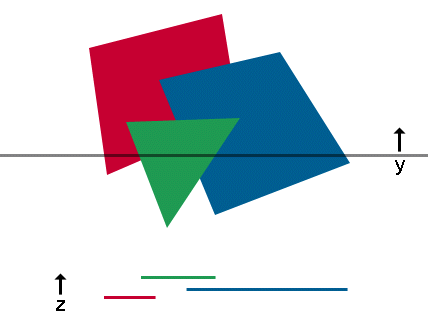at each scan line, sweep across active edges in X.
The single-polygon case: 
for overlapping polygons, an extra step:
- find the edge with lowest Z - how? - and draw that color.

Scan Conversion w/o Z buffering
The single-polygon case: 
for overlapping polygons, an extra step:

Avoid drawing occluded pixels
algorithm
Initialize depth values to infinity (and color vals to some background
color)
Draw (usually scan-convert) all the scene objects in any order
use: OpenGL
time: O (xyd), where d is the depth complexity
coherence: none
scene footprint: total (depends on who's feeding the objects
in)
memory footprint: size of the Z buffer, and the memory to scan-convert
an object
overdraw: total
color values gratuitously stored to the framebuffer: none
(front-to-back) to total (back-to-front)
clipping: not done
transparent objects: not supported (Alpha-buffers do this)

requires an extra step over traditional Z buffering - propagate up new depth values.
for each object
time, worst case, back-to-front drawing: O (d xy l) where
l is the # of hierarchy levels (log s)
d is the depth complexity
*time, usual case: O(unknown)
*coherence: object and image-space
scene footprint: depends on who's feeding the objects in.
memory footprint: size of all the Z buffers
overdraw: total, assuming the Z compare is the last step after
rasterizing, clipping & shading
clipping: can be done
transparent objects: not supported